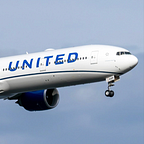What Are the Purposes of Aircraft Winglets?
Have you ever wondered why some planes’ wings curve upwards at the ends? Those are winglets! Winglets not only make the plane look cooler, but winglets decrease drag and decrease fuel consumption. Since its development by NASA in the 1970s, winglets are now an industry standard among commercial aircraft.
Problem: Wingtip Vortices
Before diving into the purpose of winglets, we need to first understand the concept of wingtip vortices.
Wingtip vortices are swirling tunnels of air that form around an aircraft’s wingtips. Because the air pressure is higher under the wing than above the wing, high-pressure air escapes from under the wing around the wingtips to the low-pressure region above. This movement creates a vortex of air, rotating inward toward the fuselage.
Wingtip vortices generate drag by angling the wings’ lift backward, turning some potential lift into drag. One thing to keep in mind is that a wing generates lift perpendicular to the relative wind. If wingtip vortices do not exist, the lift vector would point straight up. However, when there are wingtip vortices, the wingtip vortices push air up over the wing, causing wind passing by to be directed downwards. This angles relative wind downward and hence tilts the lift vector backward.
Solution: Winglets
How do winglets help, then?
Winglets are actually small vertical wings that generate lift. Just like the aircraft’s main wings, they generate lift perpendicular to the relative wind. If there are no wingtip vortices, the winglet would generate a lift pointing toward the fuselage, which wouldn’t be helpful. However, wingtip vortices change the direction of the relative wind at the wingtips (as shown in the diagram below).
The direction of the relative wind at the wingtips is now bent inward due to the vortices generated, which spin inward. Due to this, the lift that winglets generate now (perpendicular to the relative wind) points partially forward. This means that the addition of winglets actually pushes the aircraft forward and generates “forward lift”!
Even though this doesn’t seem like much, it cancels out most of the drag produced by the wingtip vortices, making the aircraft much more efficient. (Even compensates for the added weight winglets cause!)
As winglets reduce drag, winglets also decrease fuel consumption, increase fuel efficiency, increase cruise speed, and increase range.
Types of Winglets
Different planes have different types winglets, but essentially they all preform the same task. And — if you show an aviation enthusiast only a plane’s winglet, they’ll likely be able to tell you what the plane is.
- Canted Winglets: Canted winglets are found on 747–400s, A330–200/300s and A340s. These winglets are noticeably short and sloped upwards at an angle.
- Blended Winglets/Sharklets: Blended winglets are mostly found on 737NGs, 757s, 767s, and A350s. Sharklets are pretty much the same as blended winglets and are used on A320s. These winglets are tall and skinny, blended into the wing forming a smooth curve. Some blended winglets may be detachable!
- Split-Scimitar Winglets: Split-scimitar winglets are found on 737NGs and 737 MAXs. Split-scimitar winglets, as the name suggests, look like two smaller winglets extending at an angle to two different directions. Split-scimitar winglets are Boeing’s new generation of winglets, designed to improve upon the design of blended winglets.
- Wingtip Fences: Wingtip fences are like split-scimitar winglets, but wingtip fences are angled vertically. Used on A300s, A310s, some old A320s and A380s.
- Raked Wingtips: Although not necessarily a winglet, raked wingtips are found on 747–8s, 777–200LR/200F/300ER/8/9s, and 787s. Raked wingtips produce the same effects as traditional winglets, but with the benefit of no added weight on the aircraft.
Supersonic Aircrafts
Key point: supersonic planes don’t use winglets. Why? The added weight of the winglets makes it not worth it for planes where speed is the priority. Additionally, fuel efficiency isn’t as important to supersonic planes as to commercial civilian airliners.
Conclusion
Since their invention in the 1970s, winglets have been a crucial role in maximizing fuel efficiency in civil aviation. In the current day, some companies are still developing new-generation aft-sweeping winglets, similar to ones found on the 787. Nevertheless, winglets are a smart and inexpensive way to instantly improve a plane’s fuel efficiency and range.
